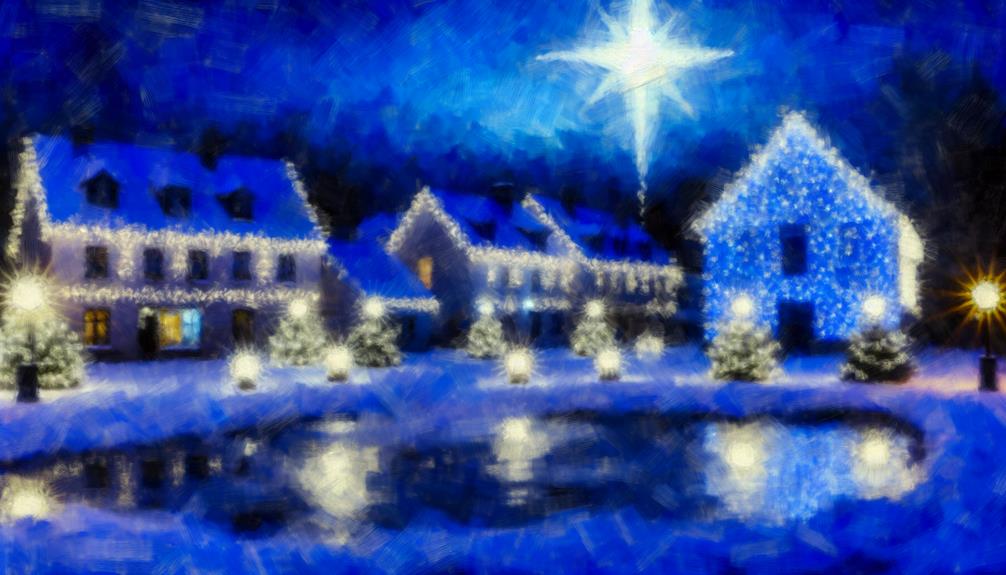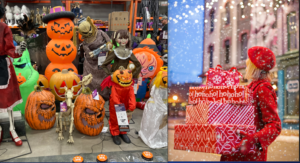Christmas tinsel, a staple in holiday decor, originated in 1610 in Nuremberg, Germany, initially crafted from real silver to reflect the glow of candlelight. Today, it’s made from durable PVC, shining bright without the tarnish. Tinsel gained famous followers like Queen Victoria, making it a festive icon. Think of it as the sparkly ribbon that wraps up holiday cheer, adorning trees, wreaths, and even gifts in dazzling arrays of color. While bringing nostalgic charm, tinsel has evolved to be safer for families, especially with curious kids and pets around. Stick around, and discover even more about this glittery holiday tradition.
Takeaways
- Christmas tinsel originated in 1610 in Nuremberg, Germany, initially made from real silver strands.
- Modern tinsel is primarily made from polyvinyl chloride (PVC), offering durability and a reflective, shimmering quality.
- Tinsel enhances festive decorations, symbolizing flair, nostalgia, and superficial grandeur.
- It is used on Christmas trees, garlands, wreaths, and gift wrapping, reflecting a nostalgic trend in contemporary decor.
History of Christmas Tinsel
The history of Christmas tinsel dates back to 1610 in Nuremberg, Germany, where it was originally crafted from real silver strands to enhance the reflective glow of candlelight on Christmas trees. This shimmering decoration quickly became a symbol of festive cheer. Imagine the warm, flickering light dancing off those delicate silver threads, creating a magical ambiance for holiday gatherings.
As tinsel’s popularity spread, it reached the shores of England. The trend truly took off in 1846 when Queen Victoria and Prince Albert decorated their Christmas tree with it. Their royal endorsement made tinsel the must-have decoration in British households, and this influence soon crossed the Atlantic to America.
However, using real silver proved impractical over time, as it tarnished and was expensive. Innovators then turned to more affordable and durable materials like copper and aluminum. By the early to mid-20th century, lead-based tinsel became prevalent, though it was discontinued in the 1960s due to health concerns.
Today, most tinsel is made from PVC, offering a safer, more colorful, and economical option. This evolution in materials has guaranteed that tinsel remains a beloved part of our holiday traditions.
Figurative Uses of Tinsel
When it comes to figurative uses of tinsel, we see it represent both flair and superficiality in various contexts.
In Germany, military awards are humorously called ‘Lametta,’ likening their shiny appearance to Christmas decorations. The proverb ‘Früher war mehr Lametta!’ nostalgically mourns the lavishness of the past.
Additionally, media references, such as in the song ‘Helenenmarsch’ and the film ‘Weihnachten bei Hoppenstedts,’ use tinsel to mock vanity and highlight its cultural significance during the holiday season.
Military Awards Symbolism
Drawing parallels between military awards and tinsel, German culture often uses the term ‘Lametta’ to emphasize the shimmering prestige and ostentation associated with such honors.
Just as tinsel is used to decorate Christmas trees, making them sparkle and stand out, ‘Lametta’ decorates soldiers with medals and ribbons, highlighting their achievements and valor. This term not only evokes the visual splendor but also the sense of pride and recognition that comes with being decorated.
In German expressions, ‘Lametta’ symbolizes more than just decoration. It captures a sense of nostalgia and grandeur, as reflected in the phrase ‘Früher war mehr Lametta!’ which translates to ‘There used to be more tinsel!’ This saying implies that things were once more splendid, much like the glittering decorations of the past.
To illustrate the significance of ‘Lametta’ in military contexts:
- Prestige: The shiny medals symbolize honor and achievement.
- Recognition: Decorations serve as a public acknowledgment of service.
- Visual Impact: The glittery appearance enhances the ceremony’s grandeur.
- Cultural Significance: ‘Lametta’ is a term infused with tradition and respect.
Thus, the use of tinsel in describing military awards melds the concepts of decoration, honor, and cultural richness.
Cultural Proverbial Expressions
In cultural proverbial expressions, tinsel often symbolizes fleeting beauty and superficial grandeur, evoking a sense of nostalgia and a longing for past splendor.
In Germany, the phrase ‘Früher war mehr Lametta!’ or ‘There used to be more tinsel!’ captures this sentiment perfectly, expressing a wistful yearning for the glittering days gone by. This saying conjures images of a beautifully decorated tree, adorned with shimmering tinsel, representing a time when everything seemed more magnificent.
Interestingly, the term ‘Lametta’ has also been used to describe military awards, drawing parallels between the ceremonial nature of these decorations and the glittery appeal of tinsel. This dual usage highlights tinsel’s role in symbolizing both honor and the decorative aspects of life’s achievements.
The film ‘Weihnachten bei Hoppenstedts’ humorously depicts this, showcasing the importance of tinsel in family traditions and the festive spirit of Christmas.
Furthermore, the song ‘Helenenmarsch’ references tinsel, emphasizing its cultural resonance and association with celebration and indulgence.
Whether on a decorated tree or used metaphorically, tinsel continues to evoke a sense of wonder and a connection to cherished memories and traditions.
Tinsel in Media
Tinsel has been metaphorically employed in various forms of media to symbolize superficiality, transient beauty, and the allure of outward appearances. This decorative element, originally made from heavy metals such as silver, found its way into the cultural lexicon far beyond the Christmas tree decorated for the holidays.
Consider these examples:
- The German term ‘Lametta’: Besides meaning tinsel, it describes military awards, paralleling formal dressing with ornamental splendor.
- The proverb ‘Früher war mehr Lametta!’: This saying reflects nostalgia for the perceived glamour and abundance of the past, often used to critique modern simplicity.
- The film ‘Weihnachten bei Hoppenstedts’: This humorous film highlights the importance of tinsel in a family’s Christmas traditions, showcasing how deeply ingrained such decorations are in festive culture.
- Hermann Göring’s appearance: The metaphorical comparison of Göring to ‘Lametta’ underscores the term’s cultural resonance, extending its use beyond holiday decor to critique ostentatiousness.
Even in music, the song ‘Helenenmarsch’ includes references to tinsel, illustrating its presence in broader cultural and artistic contexts.
Consequently, tinsel, with its shimmering allure, transcends its decorative origins, symbolizing a complex interplay of beauty, nostalgia, and vanity in media and beyond.
Modern Tinsel Materials

Modern tinsel, primarily crafted from polyvinyl chloride (PVC), offers a flexible and durable alternative to traditional metal tinsel while maintaining an eye-catching, shiny appearance. This modern tinsel is not only lightweight but also easy to handle, making it a popular choice for festive decorations.
PVC, a type of plastic known for its affordability and versatility, allows tinsel to come in a wide array of colors, enhancing its appeal.
The production of modern tinsel involves a fascinating process. Manufacturers use metal evaporation to achieve a metallic finish on the PVC strands, giving them their reflective, shimmering quality. This method guarantees that the tinsel catches the light just right, adding sparkle and magic to any holiday setting.
Unlike older versions made from metals that could tarnish or pose health risks, PVC tinsel is non-toxic, making it a safer option for households, especially those with young children or pets.
One of the greatest advantages of plastic tinsel is its versatility. Beyond decorating Christmas trees, it can be used in various festive displays, such as garlands and gift wraps. This adaptability makes modern tinsel a must-have for any holiday enthusiast looking to add a touch of sparkle to their celebrations.
Storing Tinsel Post-Christmas
As the holiday season wraps up, storing your tinsel properly can make next year’s decorating much easier and more enjoyable.
Carefully removing tinsel from the tree and wrapping it around a piece of cardboard can help prevent messy tangles.
Additionally, placing the wrapped tinsel in a zip-top bag keeps it dust-free and ready for reuse, extending its lifespan and reducing waste.
Proper Tinsel Storage Solutions
Making sure your tinsel remains in pristine condition for future festivities involves implementing effective storage solutions post-Christmas. Proper tinsel storage not only preserves its sparkle but also makes decorating easier next year.
- Wrap Around Cardboard: To keep tinsel neat and organized, wrap it around a piece of cardboard. This prevents it from becoming a tangled mess and guarantees it’s ready for effortless decorating next season.
- Use Zip-Top Bags: Place the wrapped tinsel into zip-top bags. These bags protect tinsel strands from dust and damage while keeping them easily accessible. This method also saves space and keeps your storage area tidy.
- Remove from Tree: Always remove tinsel from the Christmas tree before storing it. Leaving it on the tree can cause it to get tangled and damaged, making it harder to use in the future.
- Cool, Dry Place: Store tinsel in a cool, dry place to maintain its shine and prevent deterioration. Humidity and heat can dull its sparkle and weaken the material, reducing its lifespan.
Lastly, consider labeling your storage containers. This small step makes it easy to identify and locate your tinsel, facilitating a smooth shift into the next holiday season.
Prevent Tinsel Tangling
Preventing tinsel tangling post-Christmas involves methodically winding it around a piece of cardboard to keep it organized and untangled. This simple step guarantees that your tinsel, that magical decorative material, remains in pristine condition for next year. Imagine the frustration of pulling out a tangled mess when all you want is a quick decorating session. By wrapping each strand around a cardboard piece, you save yourself a lot of hassle.
Once wrapped, place the tinsel neatly in zip-top bags. These bags not only help maintain the shape but also offer easy access when you need it. It’s like having a tinsel treasure chest! For those who enjoy variety, consider separating different colors or styles into individual bags or containers. This separation allows for a speedy decorating process next holiday season, avoiding mix-ups and guaranteeing each type of tinsel is readily available.
If you’ve adorned a live tree, patience is key. Let the tree dry completely before removing the tinsel to minimize breakage and tangling.
Reusing Tinsel Efficiently
Proper post-Christmas storage of tinsel not only preserves its quality but also facilitates a smoother decorating process in subsequent years. To guarantee that your tinsel remains in top condition, follow these effective steps for storing it.
- Careful Removal: Gently remove the tinsel from the tree to avoid tangling or damaging the strands. This initial step is essential for maintaining the tinsel’s appearance and usability.
- Wrap Around Cardboard: Use a piece of cardboard to wrap the tinsel strands around. This method keeps them from tangling and makes them easier to handle when decorating next year.
- Use Zip-Top Bags: Place the wrapped tinsel strands in zip-top bags. This organized approach prevents dust accumulation and keeps the tinsel clean and ready for reuse.
- Avoid Excessive Folding: When storing, avoid crushing or folding the tinsel excessively. Over-folding can lead to creases and damage, reducing the tinsel’s longevity.
Additionally, consider labeling your storage bags or boxes with the year or type of decorations. This simple act streamlines the process of finding the right tinsel for your next Christmas celebration, guaranteeing a hassle-free and joyful decorating experience.
Properly storing tinsel can save time, reduce frustration, and maintain the festive sparkle year after year.
Tinsel in Contemporary Decor

Contemporary Christmas tinsel, primarily made from lightweight and cost-effective PVC, has become a versatile and vibrant addition to modern holiday decor.
Whether you’re looking to decorate Christmas trees or add a festive touch to other decorations, tinsel offers a dazzling array of colors and styles to match any holiday theme. The sparkle it brings can transform a simple tree into a centerpiece of holiday joy, catching and reflecting lights in a way that makes the whole room glow.
In today’s homes, tinsel isn’t limited to just trees. Imagine draping tinsel around garlands and wreaths, or even using it to wrap gifts with an extra touch of glitter.
This resurgence in tinsel’s popularity is partly due to a nostalgic trend, as many people seek to recreate traditional Christmas aesthetics. It’s a nod to the past, wrapped up in the shimmer and shine of modern materials.
Moreover, tinsel’s versatility extends beyond trees and garlands. Festive displays at stores, embellishments on holiday cards, and even creative DIY projects can all benefit from the addition of tinsel.
It’s a small touch that brings big cheer, making every corner of your home feel a bit more magical.
Safety and Alternatives
Assuring the safety of your holiday decorations is paramount, particularly when considering the potential risks that tinsel poses to pets and small children. Shiny tinsel strands might look enticing, but they can lead to choking or digestive issues if ingested.
To create a festive yet safe environment, here are some practical tips and alternative decorations:
- Ribbon and Paper Garlands: These alternatives can provide a similar festive flair without the risks associated with tinsel. Plus, paper garlands are often recyclable, making them an eco-friendly choice.
- Secure Placement: If you prefer using tinsel, make certain it is securely hung out of reach of curious pets and children, reducing the chances of accidental ingestion.
- Non-toxic Decorations: Prioritize non-toxic and child-safe decorations. Look for labels that confirm the safety of decorative items, particularly if you have young children or pets prone to chewing.
- Supervision: Always supervise areas where potentially harmful decorations are placed. Keep an eye out to assure that pets and children do not have access to these items.
Tinsel’s Cultural Impact

While ensuring the safety of holiday decorations is essential, understanding tinsel‘s cultural impact provides a richer appreciation of its role in festive traditions worldwide.
Tinsel, first used in Germany in 1610, was originally crafted from real silver strands, symbolizing luxury and elegance. The shiny strands were designed to reflect candlelight on Christmas trees, making them sparkle with a magical glow. In Germany, tinsel is also known as ‘Lametta,’ a term used for military awards, underscoring its association with prestige and celebration.
Tinsel’s popularity soared in England during the Victorian era, especially after Queen Victoria and Prince Albert showcased a tinsel-decorated tree in 1846. This royal endorsement greatly influenced Christmas traditions in both British and American societies, cementing tinsel as a staple in holiday décor. There’s even a nostalgic German expression, ‘Früher war mehr Lametta!‘ which laments the past when tinsel was more prevalent in holiday celebrations.
Moreover, tinsel’s cultural significance extends beyond Western traditions. In countries like India, tinsel is traditionally used in festive decorations, showcasing its adaptability and universal appeal.
Frequently Asked Questions
Why Is Tinsel Illegal?
Tinsel containing lead is illegal due to significant health concerns, particularly lead poisoning. Regulatory bodies, such as the U.S. Consumer Product Safety Commission, have enforced bans to guarantee consumer safety, leading to the development of safer alternatives.
What Is the History of Christmas Tinsel?
Christmas tinsel originated in 1610 in Germany, initially made from real silver. Its popularity surged in England in 1846 due to Queen Victoria. Modern tinsel, crafted from PVC, offers a safer, affordable alternative, preserving nostalgic holiday charm.
What Is the Meaning Behind Tinsel?
Tinsel symbolizes the festive spirit and opulence of Christmas, originating from its historical use of silver to reflect candlelight. It evokes nostalgia for traditional celebrations and represents the sparkle and glamour of holiday decorations.
Why Was Tinsel Discontinued?
Tinsel was discontinued in the 1960s due to health concerns related to lead poisoning, particularly affecting children and pets. Manufacturers subsequently shifted to safer alternatives, such as PVC, to mitigate these significant health risks.
Conclusion
Basically, Christmas tinsel has journeyed from its historical origins to become a beloved part of holiday decor.
Its versatility extends beyond decoration, finding roles in various artistic and cultural expressions.
Modern advancements have diversified its materials, ensuring safer and more sustainable options.
Proper storage can prolong its use, while contemporary decor continues to embrace its sparkle.
Understanding tinsel’s cultural impact enriches appreciation for this shimmering symbol of festivity.













